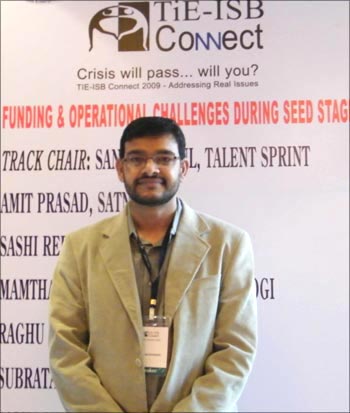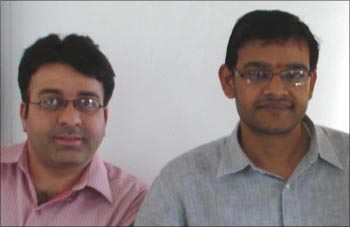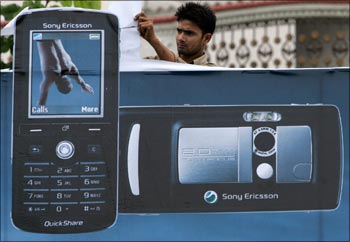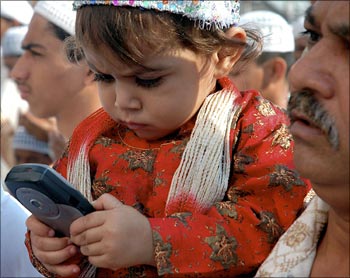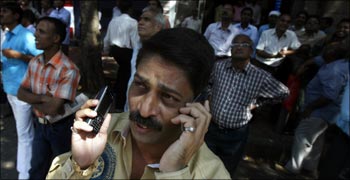 | « Back to article | Print this article |
Story of a top Indian entrepreneur
Sunil Maheswari, the chief executive officer and co-founder of Mango Technologies Pvt Ltd, has many accomplishments to his credit. MINT-Wall Street Journal described Mango Technologies as one of the 'Top Ten Startup Companies of 2008'.
In 2007, he won the top innovation award from Nasscom and recently, Business World named him one of the top five entrepreneurs in India. Sunil had managed the team that designed the first 'Designed in India' mobile set and the world's first dual SIM phone.
Mango Technologies is a software solution provider for all low and medium segment mobile phones.
At the 'Jumpstart Your Venture' workshop of the recently concluded TiE-ISB Connect 2009, Sunil Maheswari spoke of starting up a venture. Rediff.com caught up with him after the presentation, and here is his story. Read on. . .
Story of a top Indian entrepreneur
Desire to be an entrepreneur
I had the desire to be an entrepreneur very early; when I was in college itself. I started dreaming about what I should do after my studies. I was influenced by the stories of all the entrepreneurs in India right from the Tatas and the Birlas.
I took the first risk in my career by quitting my job at Reliance Infocom to join a startup company. That was when I saw entrepreneurship up close. I was the second person to join the company. That was where my close encounter with entrepreneurship started. I was doing many things there, including all the nitty-gritties.
We designed a complete mobile handset and that was the first 'Designed in India' handset. It was also the first dual SIM phone. It was a proud moment for us when we could show the phone to the then President Dr APJ Abdul Kalam.
Story of a top Indian entrepreneur
The idea germinates
The year was 2006. It was the right time for an engineer as the market was up and we were getting fancy salaries. It took only one or two months for me to take the decision that I was going to start an enterprise of my own. My family -- my wife -- was very supportive and my friend Lekh Joshi also was supportive. So, we did not face any kind of hurdle.
I come from Rajasthan where there are a lot of entrepreneurs. So we did not look at starting an enterprise as a risk.
We also did some market analysis and found that even if we failed, there would be other opportunities. But we were sure of one thing; we did not want to lose time.
I and Lekh Joshi sat and discussed product ideas, products and what we wanted to do. Probably it was the mango season! We decided to name our product Mango! It did not take us long to reach the name. And the company name came from there.
We also wanted an identity and we thought the word Mango reminded us of something that we consume quite often.
As both I and Lekh worked in the mobile phone domain, we knew that our product also would be in that area.
Story of a top Indian entrepreneur
Starting an enterprise
We started Mango Technologies in Bangalore with less than Rs 10 lakh (Rs 1 million). We were lucky in the sense that we started our operation from our house. A friend who was running a company had some unused area with PCs and we started working from there by giving a small equity to him.
We didn't have any operational expense then as first we operated from my home, and then from my friend's place.
We hired two people. We started building a complete operating system for mobiles. We had a good understanding of the market and some of our potential customers. So we knew where we are going to work and who we are going to target.
Story of a top Indian entrepreneur
The mobile market
By 2006, the mobile market had already started to boom. We saw a healthy demand not only in India but in the other emerging markets also. That's when we decided that emerging markets needed a different kind of software, not just what you get from China, Korea, etc.
The requirement in India is different from the requirements of China, Japan or the United States.
Indians are cost-conscious consumers. In the US, $300 or $400 phones are very common and operators subsidise and give them to consumers, but in India, that is next to impossible.
So we are very cost-conscious but we want the best: best devices, best services, best user experience. We are okay spending money in parts. Even the autowallahs are ready to spend Rs.5 for value-added services like downloading a ringtone but not okay in spending Rs 5,000 for a handset. It is a constraint. So for all device makers, it was a big challenge to make a set suitable for this kind of market.
Story of a top Indian entrepreneur
First customers
We started partnering with Texas Instruments first and then we started working with Qualcomm and they are our number one customer, and they command about 20-25% of the world market in mobiles.
They are the number one mobile semi-conductor company and we are shipping with them. We have many language supports so that they can customise for various countries.
Awards
We won Nasscom's most innovative company award in 2007-08. Mint and Wall Street Journal wrote our company as part of the top ten startup companies of 2008, and recently, we were in the top ten innovators list published by Business World. All these awards really boosted our confidence. It helps attract good talent also.
Story of a top Indian entrepreneur
Journey so far
Nothing is easy in life. With support from our families and the initial set of employees, our journey so far has been not that bad; in fact, it has been quite satisfying.
I believe that any time is the right time and every place is the right place. Even in the worst times, people have started successful companies. I don't think any time is wrong time.
I feel you can create your own niche any time and you need to change your plans as per what you see for future.
We are generating profits and investing them back in the company. Starting with the two of us, we now have 35 full-time employees. We have two offices now; one in Bangalore and another in Jaipur.
The journey is still continuing.
Story of a top Indian entrepreneur
Future plans
We want to become world's number one mobile platform company in this segment which is the bottom 50% segment. We want to be in as many handsets as possible and give better service to our consumers.
Qualcomm takes us to many more customers but in the next step, when our software is available in millions of handsets, we want to directly work with end consumers and the developer community.
You need to create more jobs and more wealth in this country and the only way to grow is through entrepreneurs. If you look at all the successful economies, you will see that wealth is created by first time entrepreneurs. In India, Infosys, Wipro, Reliance are the best examples.
